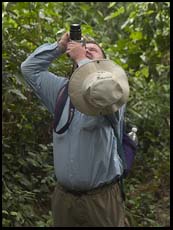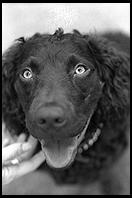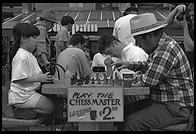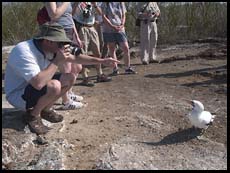
Building a digital SLR system: Looking at the Canon Digital Rebel XTi, Nikon D40, Nikon D80, and EOS 5D cameras
by Philip Greenspun
Digital single-lens reflex (SLR) cameras are the standard tool for serious photographers. With the introduction of cameras such as the Nikon D40 and the Canon Digital Rebel XTi the market for digital SLR cameras has expanded tremendously. A point-and-shoot compact digital camera can offer reasonably good image quality, but a digital SLR, which usually looks a lot like an old standard 35mm film camera and may use the same lenses, offers the following advantages:
- accurate, large, and bright optical viewfinder
- fast operation and large controls
- excellent image quality in low "available" light situations when it is necessary to use higher ISO speeds
- interchangeable lenses
For more information on what to consider when purchasing a DSLR, including details on lens compatibility, system expandibility, size and weight, ISO settings, noise levels, etc, take a look at Bob Atkins' article on Factors to Consider when Choosing a Digital SLR Camera.
With the digital SLR you have a good idea of what you're going to capture by looking through the viewfinder. When you press the shutter release the camera captures the image immediately. If you need to zoom or focus manually there are large rings that you can operate quickly by feel. If you see a beautifully-lit scene you can capture that beauty instead of using an on-camera flash to blast everything with harsh white light. If you need to make a specialized photo, you can buy or rent a specialized lens and attach it to the camera.
This article explains the different kinds of digital SLR cameras available, how to choose the right one for you, and what to do once you get it home from the shop. A digital SLR camera system, complete with lenses and accessories, can cost anywhere from $600 to $10,000. This article shows you how to choose and buy the basic items first and the more expensive and hard-to-use components later.
[If you don't want to read this article and are impatient to get started immediately, get a Canon Digital Rebel XTi (review) and Sigma 30mm f/1.4 EX DC for Canon, $439; if you must have a zoom, the Canon EF-S 17-55 f/2.8 IS USM, $960 (review) is a good choice.]
What is a single-lens reflex (SLR)?
The single lens reflex (SLR) is most folks' idea of a serious camera. "SLR" means that the same lens is used for viewing and taking pictures. A mirror in the body directs the light from the lens up into a prism for viewing, then flips up out of the way just before an exposure is made. The standard photojournalist's Nikon from the 1960s or 1970s was an SLR with a roll of 35mm film behind the mirror. When the mirror came up the light passed through to the shutter, which opened to expose one frame of film for perhaps 1/60th  of a second. A Canon Digital Rebel or Nikon D80 looks very similar and works in almost the same way. The only difference is that instead of a piece of film behind the shutter there is an electronic sensor.
of a second. A Canon Digital Rebel or Nikon D80 looks very similar and works in almost the same way. The only difference is that instead of a piece of film behind the shutter there is an electronic sensor.
The mirror and optical viewfinder are what enable a photographer to frame images more quickly and accurately than with a point-and-shoot camera. Regardless of what lens or filters you have attached to the camera you see what the sensor will see. The same can be said for the LCD displays on the back of a $200 point-and-shoot camera but those displays are difficult to interpret in sunlight. The typical digital SLR camera viewfinder offers additional information underneath the image, including all the most important camera settings.
The SLR is much larger and heavier than the point-and-shoot camera. If you are leaving the house to socialize and want a camera to keep in your pocket just in case an interesting photo presents itself, the SLR will seem cumbersome. If you are heading out specifically with a photographic project in mind you will appreciate how the SLR and its controls fit into your hands
Because digital SLRs are more expensive than point-and-shoot cameras the manufacturers typically put in faster computers and better autofocus systems. This makes the cameras more responsive and you are more likely to catch the "decisive moment" as the baby's face lights up with a smile, the soccer ball leaves the player's foot, or the dog catches the frisbee.
A digital SLR may offer the same number of megapixels, individual image elements, as a high-end point-and-shoot. Not all pixels are created equal, however. Resolution is important if you intend to make large prints but dynamic range, the ability to capture detail within bright highlights and dark shadows, is more critical in many situations. The sensors in digital SLRs are typically much larger than those found in point-and-shoot cameras. The main advantage of a larger sensor is better performance in dim light. If there are 8 megapixels spread out over a sensor that is 4 times larger than the sensor in a point-and-shoot camera that means more photons of light will fall on any given pixel. If during an exposure 50 photons would fall on the small sensor then 200 photons would fall on the big sensor. If there is a small change in the light from one part of the scene to another the sensor in the point and shoot camera is trying to notice a single extra photon; the electronics in the camera with the big sensor have four extra photons that are much easier to detect.
First-time consumers of digital SLR cameras focus on the body. Long-time photographers, however, look at the system. An SLR system includes a body, multiple lenses, flash units, and various connecting cords. For most photographers the investment in lenses will come to dwarf the cost of a body. It is thus important to choose a system whose manufacturer makes the lenses that you need for all of your potential projects and, ideally, whose system is popular enough that you can rent special-purpose lenses for uncommon situations. Each camera system has its own lens mount design and a lens that works on, say, a Nikon camera cannot be attached to a Canon body.
Who makes digital SLR cameras?
The same companies that made 35mm film SLRs make digital SLRs. If you have a lot of Canon EOS lenses from your days as a film photographer, for example, you will probably want to buy a Canon EOS digital camera, because those lenses from the 1990s will work just fine on the new digital camera.
The market leader in the professional/advanced amateur photography world is Canon. If you don't have a major investment in lenses you will probably want to buy a Canon digital SLR. The number two spot is occupied by Nikon, which is also a reasonable choice. Fuji and Kodak have made digital SLRs that accept Canon- and Nikon-mount lenses. Once you get beyond Nikon and Canon it becomes very difficult to rent lenses and the companies that make the more obscure systems don't have a large enough market share to invest enough money to build competitive bodies. Leica, Minolta, Olympus, Pentax, and Sigma are the small vendors in the digital SLR market. Unless you have an enormous investment in lenses for one of these brands the only one of these worth considering for purchase is Olympus, due to its innovative Four-Thirds system, discussed below.
What kinds of digital SLRs are available?
There are three kinds of digital SLR systems being made as of September 2005:
- big lenses, big sensor
- big lenses, small sensor
- small lenses, small sensor
- We will discuss each in turn.
Big lenses, big sensor. Canon and Kodak have taken the most obvious approach to the challenge of transitioning from film to digital: build a digital sensor exactly the same size as one frame of 35mm film. The result is a chunk of silicon 24x36mm in size, which is vast  compared to the sensor in a point-and-shoot digicam. The benefit of this vast sensor is reduced noise, which looks like grain, in low light/high-ISO situations. The drawback of a vast sensor is that manufacturing a flawless piece of silicon this big is very expensive. Consumer-priced cameras in this category include: Canon EOS 5D, $2000 (review), Canon EOS 5D Mark II (review), Nikon D700, $2399 (review), Nikon D3, $4350 (review), and Sony Alpha A900, $2699 (review). If you have a strong back and an unlimited budget, the Canon EOS 1Ds Mark III, $6999 (review), is a great choice. It is probably the best digital camera made and produces image quality that rivals medium format film (e.g., 6x6cm Hasselblad).
compared to the sensor in a point-and-shoot digicam. The benefit of this vast sensor is reduced noise, which looks like grain, in low light/high-ISO situations. The drawback of a vast sensor is that manufacturing a flawless piece of silicon this big is very expensive. Consumer-priced cameras in this category include: Canon EOS 5D, $2000 (review), Canon EOS 5D Mark II (review), Nikon D700, $2399 (review), Nikon D3, $4350 (review), and Sony Alpha A900, $2699 (review). If you have a strong back and an unlimited budget, the Canon EOS 1Ds Mark III, $6999 (review), is a great choice. It is probably the best digital camera made and produces image quality that rivals medium format film (e.g., 6x6cm Hasselblad).
The only other full-frame digital SLRs made were the discontinued Kodak DCS Pro SLR/n and SLR/c bodies. The Kodaks were cheaper than the Canon, but not quite as functional and the fact that they were discontinued is a good illustration of why you want to buy a digital SLR from a market leader. I own a 5D and have written a full review of the Canon EOS 5D.
Big lenses, small sensor. In order to keep the cost of the body within a range of $700-1500 and allow photographers to use their old 35mm system lenses most digital SLRs fall into this category. The front of the body has the same lens mount as an old film SLR. The back of the body has a sensor that is smaller than the 24x36mm standard frame of an old film SLR. The result is a camera that looks the same as the old film camera but multiplies the magnification of all the lenses. Having a smaller sensor is like cutting the center out of a drugstore proof print. You don't capture all the information on the left and right and top and bottom of the frame. It is as though you took the picture with a telephoto lens. The viewfinder has been adjusted so that what you see optically is what is captured in the digital file. If you're coming from the film world you will need to do a mental adjustment. A 50mm normal perspective lens on a big lens/small sensor camera behaves like an 80mm telephoto lens on a film camera. A 20mm ultra wide-angle lens behaves like a 30-32mm slightly wide angle lens on a film camera. Nearly all the popular digital SLRs fall into this category and their various merits will be discussed below.
Small lenses, small sensor. The biggest problem with the "big lens, small sensor" situation is that photographers are forced to cart around lenses that are much larger, heavier, and, theoretically, more expensive, than they need to be. A big heavy Canon telephoto lens is big and heavy mostly because it is built to cast an image circle large enough to cover a 24x36mm frame but the Canon EOS 30D body's sensor is only 15x22mm in size. Any engineer would look at this "big lens, small sensor" situation and say "Why not come up with a standard reasonable sensor size and then make lenses that are just large enough to cover that sensor with an image?" That's precisely what the Four Thirds consortium did. Olympus and Kodak seem to be the originators of the standard but Fuji, Panasonic, Sanyo, and Sigma have signed on as well according to www.four-thirds.org. This seemed like a great idea at the time (2002) but four years later only three Four Thirds system bodies have been built, all by Olympus, and only a handful of lenses, all from Olympus and Sigma.
If you have a a robust checking account and/or a lot of Canon EOS film camera lenses an unlimited budget the "full-frame" Canon EOS-5D (big lenses/big sensor; medium weight; $2900) is the obvious choice. If you don't need state-of-the-art performance and value compactness above all, the Olympus E System is a reasonable choice (see my review of the Olympus E1 for more detail; the current best buy is a complete starter kit with the E-500 for $630 from amazon). More than 90 percent of photographers, however, will find that the engineering compromise of "big lenses/small sensor" fits their budget and needs. This has led to the introduction of lenses that have the big lens mount for a 35mm film camera but optically cover only the small sensor of a mid-range digital SLR. These are sold as "digital-only lenses" or "digital camera lenses" but in fact they won't work on a full-frame digital SLR--the corners of the image would be black. Canon denotes these lenses as "EF-S", Nikon as "DX".
Which big lenses/small sensor digital SLR to buy?
Canon is the strongest competitor in the digital SLR market. Their current (2006) big lenses/small sensor options include the following cameras:
- Canon Digital Rebel XTi (review); 485g; called "Canon EOS 400D" outside the U.S.; introduced fall 2006
- Canon EOS 30D (review); 700g; introduced May 2006
These bodies are very similar in performance with sensors that are about the same size and 8-megapixels in resolution. The 30D offers better performance in low light, more responsive operation, and a rear control wheel that makes for faster operation in manual or limited-automation modes. The Digital Rebel is lighter and less bulky.
If you have a substantial investment in Nikon-mount lenses you might wish to stick with the Nikon system when buying a digital SLR. At many points in time Canon makes slightly more advanced bodies, but in virtually every photographic situation you'd end up taking the same picture with either the Canon or Nikon big lenses/small sensor body. Nikon's current (2007) options include the following:
If you have a substantial investment in Nikon-mount lenses you might wish to stick with the Nikon system when buying a digital SLR. At many points in time Canon makes slightly more advanced bodies, but in virtually every photographic situation you'd end up taking the same picture with either the Canon or Nikon big lenses/small sensor body. Nikon's current (2007) options include the following:
- Nikon D40, 18-55mm kit, $450 (review)
- Nikon D80 (review); 600g; introduced fall 2006 but based on the D70, which was introduced in early 2004
- Nikon D200 (review); introduced in March 2006
- Nikon D2Xs (review); 1070g; introduced early 2005;
All of Nikon's digital SLR cameras use the same size 16x24mm sensor, which multiplies lens magnification by 1.5. The D2Xs is the heavy professional 12-megapixel model. The D200 is the advanced amateur 10-megapixel model. The D80 is the mid-range 10-megapixel model, much lighter in weight due to its plastic body. The D40 is a delightful light compact 6 MP camera with an intuitive user interface. The D40 is the only SLR camera that shows example photos to illustrate the appropriate use of different settings.
Before you consider buying anything other than Canon or Nikon, remember that a 300/2.8 telephoto lens, the standard tool of sports and wildlife photographers, will cost around $4500 to buy and $50 to rent for a weekend. You can rent lenses for Canon
Get a body and normal lens

Lenses are specified by focal length in millimeters and aperture, a ratio between the diameter of the lens and its length. The longer the lens, the greater the magnification. A 50mm lens gives approximately the same perspective as normal human vision. A 400mm lens gives a view like looking through 8X binoculars and a 20mm lens is a dramatically wide angle lens. Lens apertures or f-stops have the following full steps: 1.4, 2.0, 2.8, 4, 5.6, 8, 11, 16, 22. Each step represents half as much light being admitted to the sensor. "50/1.4" is shorthand for a lens that is 50mm long and has a maximum aperture of f/1.4. Zoom lenses are specified with the focal length range followed by the aperture range, e.g., "24-105/2.8-4" is a lens that goes from a wide 24mm perspective to a telephoto 105mm perspective while the maximum aperture available goes from f/2.8 at the 24mm end to f/4.0 at the 105mm end. A "fast" lens is one with a wide maximum aperture, e.g., f/2.0. A "slow" lens is one with a physically small (though numerically large) maximum aperture, e.g., f/5.6. The slow lens will require a more brightly lit scene in order to deliver adequate illumination to the sensor.
You've bought, or rented, a digital camera.
It is rather unsatisfying to fool around with a camera unless you can form images on the sensor and therefore you need a lens. The cheap zoom lenses that come packaged with a Canon Digital Rebel or Nikon D50 kit are poor tools for building photography skills or making compelling images. The novice photographer who starts with a zoom lens typically uses it in lieu of backing up or stepping forward. An experienced photographer visualizes the scene first, chooses a focal length, then gets into the appropriate position to capture the scene with that focal length. It is much better to get a lens with a fixed focal length, learn to recognize scenes where that lens can be used effectively, and then add additional lenses once that focal length has been mastered. So even if you have the $1000+ to buy a high quality zoom and the muscles to lug it around it is probably a poor choice of first lens.
The $100-200 lightweight zoom lenses that come bundled with digital SLR bodies have some additional limitations. Being a good photographer starts with the ability to recognize a scene that looks attractive under its current lighting conditions. You need a lens with a wide enough maximum aperture, typically f/2.0 or f/1.4, to capture that scene even when the lighting is fairly dim, as it will be indoors or near the end of the day. An inexpensive zoom lenses will have a maximum aperture of between f/4.0 and f/5.6. At an aperture of f/5.6 you will need 8 times as much light to take a picture as you do at an aperture of f/2.0. Thus the cheap zoom will force you to use the on-camera flash, which casts an ugly flat light and in any case will render the scene completely different than it looked to your naked eye. Flash can be useful, especially with multiple strobes in the studio or as a fill-in light to reduce contrast outdoors, but mastering flash photography is a separate challenge.
The final problem with a cheap zoom lens is image quality. There is no free lunch in this world and when an optical engineer cuts cost and weight the sharpness and contrast are reduced. In fact, you might get a better quality photo with a point-and-shoot digicam than with a heavy expensive digital SLR with a cheap light zoom lens attached.
What you want for a starter digital camera lens is a high-quality "prime" lens with a fixed focal length. You want a "normal" perspective so that the relative sizes of objects in the image will be roughly what you experience with your normal vision. For a 35mm film camera or a full-frame digital SLR (Canon EOS-1Ds; Canon EOS 5D), the normal focal length is 50mm. For a Canon Digital Rebel or similar "big lenses/small sensor" camera the normal perspective is afforded by a 35mm lens. For a Four Thirds camera such as the Olympus E1, the normal lens is 25mm.
In the Canon system there are two kinds of autofocus motors available in the various lenses. The best kind of autofocus motor is ultrasonic, denoted by the "USM" designation on a lens. With USM the pure autofocus will be faster and it is also easier to let the camera do most of the focus work but manually change the point of focus if desired. For the EOS-1Ds or EOS-5D, I recommend the Canon  50/1.4 because it has the USM motor, unlike the cheaper Canon 50/1.8.
50/1.4 because it has the USM motor, unlike the cheaper Canon 50/1.8.
For the Canon small sensor DSLRs, e.g., the EOS 30D and Digital Rebel XTi, the Canon 35/2 lens is an economical lightweight choice, but sadly it lacks a USM motor. Canon makes a very fine 35/1.4L USM that lets you work in light only half as bright as the 35/2 (the "L" designation means that it is part of Canon's expensive lineup of lenses and will have superb optical performance and mechanical construction). This lens costs more than $1000, however, and, at 580 grams, is heavy. Generally speaking, "third party" lenses such as those made by Sigma, Tamron, and Tokina, are not worth considering compared to Canon-brand lenses. The remarkably cheap wide-range third-party zooms deliver terrible image quality. The high quality third-party prime lenses or fast zooms aren't much less expensive than high quality Canon- or Nikon-brand lenses. Sigma's 30/1.4 digital-only lens is an exception. Because it does not cast an image large enough to cover a 24x36mm film frame, the lens is much lighter (422g) than the Canon 35/1.4 and less than half the price (check it now). It has an ultrasonic motor, denoted "HSM" by Sigma, and has delivered superb optical performance in magazine tests.
With Nikon, your choices are simple. Nikon currently offers 2 full-frame sensor cameras: Nikon D3, $4350 (review), and Nikon D700, $2399 (review), in addition to their line of small-frame sensor cameras. They only make one 35mm prime autofocus lens, a 35/2. The Sigma 30mm f/1.4 EX DC for Nikon, $439 is probably a better choice due to its extra f-stop of light gathering capability and ultrasonic motor.
Olympus makes very few prime lenses and none with a 25mm "normal" perspective. Olympus does offer a choice of three zooms, however. The best image quality and fastest aperture is a 14-35/2.0. The "reasonably good" mid-range zoom is the 14-54/2.8-3.5. The cheapest Olympus zoom for the Four Thirds system is the 14-45/3.5-5.6, only suitable for sunny days due to its small

As noted previously, expensive digital camera bodies are often sold in kits with cheap slow zoom lenses that sell separately for a maximum of $100. If the kit is the same price as the body alone, by all means get the kit and put the included lens aside until you are letting a clumsy child experiment with your camera system. But also shop for a high quality lens of some sort.
Distilled shopping advice:
- cheapest possible system: Nikon D40, 18-55mm kit, $450 (review)
- basic family camera system: Canon Digital Rebel XTi (review), and Sigma 30mm f/1.4 EX DC for Canon, $439
- transitioning film photographer: Canon EOS 50D, $1199 (review), and Sigma 30mm f/1.4 EX DC for Canon, $439
- technophile: Canon EOS 5D, $2000 (review), and Canon EF 50mm f/1.4 USM, $400 (review)
Get some accessories
Big digital SLR cameras take not-so-very-compact Compact Flash (CF) memory cards. Often the camera body does not come with a CF card or the supplied card will only hold a handful of images. A RAW photo from an 8-megapixel digital SLR occupies roughly 10  MB of space on the card, which means that a 2 GB card will hold approximately 200 images. The RAW files from the Canon EOS 5D are approximately 13 MB in size, which means that you can get 300 images on a 4 GB card. In addition to the size of the card, it is worth looking at the maximum writing speed. A card labeled "60X", for example, can theoretically read or write 9 MB per second or one RAW 8-megapixel image per second (folks who've measured the write times of various cards in real cameras never get more than 6 MB per second, even from cards that are supposed to support 20 MB per second). The camera has a memory buffer allowing you to capture 20 or more images in rapid sequence, and then it writes them to disk as fast as the card allows. Even with a large buffer, however, you want a fast card so that the camera is responsive to requests to review recently captured images. You don't want to leave your subjects standing around for two minutes while the camera writes to the card and then you figure out whether you've gotten the images that you need. The SanDisk Ultra II cards are nearly as fast as the fastest available cards and nearly as cheap as the cheapest available cards. Don't pay extra for Lexar "write-acceleration" cards if you're using a Canon body; Canon doesn't support whatever these cards need to write faster. You can buy Sandisk cards at our vendor partner: 8 GB; 4 GB; 2 GB; 1 GB. Serious photographers don't generally use cases for SLRs. If you're out taking pictures, you want the camera available for immediate use. If you're not taking pictures, you can stuff the camera anywhere. If you are going to be taking the camera out in the rain, however, or tossing it into a backpack with a lot of rocks, I like the Zing neoprene "action covers".
MB of space on the card, which means that a 2 GB card will hold approximately 200 images. The RAW files from the Canon EOS 5D are approximately 13 MB in size, which means that you can get 300 images on a 4 GB card. In addition to the size of the card, it is worth looking at the maximum writing speed. A card labeled "60X", for example, can theoretically read or write 9 MB per second or one RAW 8-megapixel image per second (folks who've measured the write times of various cards in real cameras never get more than 6 MB per second, even from cards that are supposed to support 20 MB per second). The camera has a memory buffer allowing you to capture 20 or more images in rapid sequence, and then it writes them to disk as fast as the card allows. Even with a large buffer, however, you want a fast card so that the camera is responsive to requests to review recently captured images. You don't want to leave your subjects standing around for two minutes while the camera writes to the card and then you figure out whether you've gotten the images that you need. The SanDisk Ultra II cards are nearly as fast as the fastest available cards and nearly as cheap as the cheapest available cards. Don't pay extra for Lexar "write-acceleration" cards if you're using a Canon body; Canon doesn't support whatever these cards need to write faster. You can buy Sandisk cards at our vendor partner: 8 GB; 4 GB; 2 GB; 1 GB. Serious photographers don't generally use cases for SLRs. If you're out taking pictures, you want the camera available for immediate use. If you're not taking pictures, you can stuff the camera anywhere. If you are going to be taking the camera out in the rain, however, or tossing it into a backpack with a lot of rocks, I like the Zing neoprene "action covers".
A "UV haze" filter, appropriately sized to fit the front of your lens, can be useful if you're taking pictures in a dusty or wet environment or if you're lending your camera to a careless person. For maximum contrast and image quality, however, don't leave the filter on the lens when doing a project in a clean environment.
As far as cleaning accessories go, the most useful is a microfiber cloth. Remember to drip the cleaning fluid onto the cloth and then wipe the lens; do not drip cleaning fluid directly onto a lens. Also never try to clean an SLR mirror yourself. Dust on the mirror will not appear on your images and it is very easy to damage the mirror surface. Zeiss makes some good lens cleaning products, including their pre-moistened wipes.



